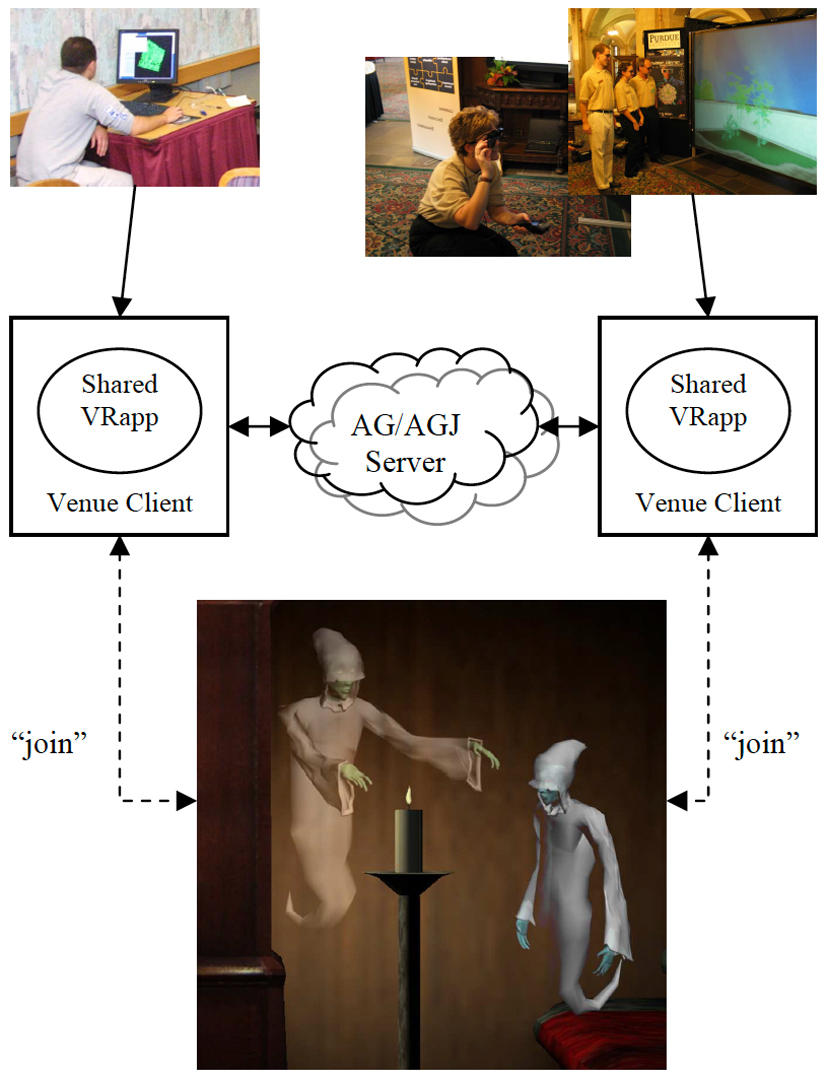“AGJuggler” by Gonzalez and Arns
Conference:
- SIGGRAPH 2005
-
More from SIGGRAPH 2005:


Type(s):
Entry Number: 35
Title:
- AGJuggler
Presenter(s):
Description:
Even though there are several theories on how new knowledge is generated through collaboration [Lipponen et al. 2004], it is generally agreed that interaction among groups or teams can be beneficial in the accomplishment of many tasks. With the globalization phenomenon and current advances in network computing, geographically distributed teams are very common in the present and technologies are developed in order to facilitate collaborative work among scientists and professionals. On the other hand, authors also agree that having the ability to immerse in a computer-generated world, and visualize and manipulate 3D data proves to be useful in many settings. Leston [1996] illustrates the benefits of virtual reality (VR) by quoting the Chinese proverb “I hear, I forget / I see, I remember / I experience, I understand” (p. 12). In order to facilitate a richer interaction among geographically distributed teams, the toolkit we have developed, AGJuggler, brings the features of virtual reality into existing collaborative technologies.
Collaboration technologies have been developed since at least the 1980s; videoconferencing was one of the first applications that became popular because it facilitates meetings without the need to travel and it also offers a great level of flexibility [Kauff and Schreer 2002]. However, collaboration is not only about distributed meetings but also sharing data, sharing resources and enabling interaction; so collaboration frameworks or environments offer several features like video/audio conferencing, shared data repositories and applications that can be executed by remote users at the same time. Some examples of such collaboration environments are Microsoft® ConferenceXP [Microsoft Corporation 2004], its predecessor NetMeeting [Microsoft Corporation 2005] and the Access Grid™ [Futures Lab n.d.].
The motivation for developing our toolkit was the belief that VR can improve interaction among participants in a collaborative environment and help overcome issues related to the sense of presence and availability of customizable solutions. There has been interest and development of multi-user VR technologies since the 1980s and 1990s [Stevens et al. 2003], however the range of applications is limited and they are often intended for a specific purpose. Most of the available applications rely on dedicated communication lines and/or don’t have other collaborative, conference-like features. The objective of our work was to take advantage of the functionality offered in collaboration environments and the features of VR, and integrate them into a toolkit called AGJuggler, a customizable solution for offering a richer collaborative experience to geographically distributed teams.
Other Information:
References
CRUZ-NEIRA, C., SANDIN, D. and DEFANTI, T. 1993. Surround-screen projection-based virtual reality: the design and implementation of the CAVE. In Proceedings of SIGGRAPH 1993, ACM Press / ACM SIGGRAPH, New York. Computer Graphics Proceedings, Annual Conference Series, ACM, 135 – 142.
FUTURES LAB n.d.. Access Grid. Retrieved June 16, 2005, from http://www.accessgrid.org
KAUFF, P., and SCHREER, O. 2002. An immersive 3D videoconferencing system using shared virtual team user environments. In Proceedings of the 4th International Conference on Collaborative Virtual Environments, ACM Press, New York, 105-112.
LESTON, J. 1996. Virtual reality: the IT perspective, The Computer Bulletin 38, 3, 12-13.
LIPPONEN, L., HAKKARAINEN, K., and PAAVOLA, S. 2004. Practices and orientations of CSCL. In What we know about CSCL: And implementing it in higher education, Kluwer Academic Publishers, Norwell, MA. J.-W. Strijbos, P. A. Kirschner and R. L. Martens, Eds., 31-50.
MICROSOFT CORPORATION 2004. Microsoft Research ConferenceXP project. Retrieved June 16, 2005, from http://www.conferencexp.net
MICROSOFT CORPORATION 2005. NetMeeting home. Retrieved June 16, 2005, from http://www.microsoft.com/windows/netmeeting/
STEVENS, R., PAPKA, M., and DISZ, T. 2003. Prototyping the workspaces of the future, IEEE Internet Computing, 7, 4, 51-58.




